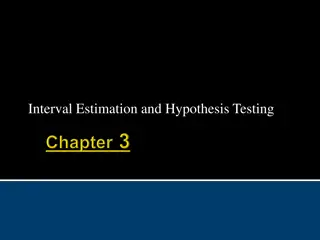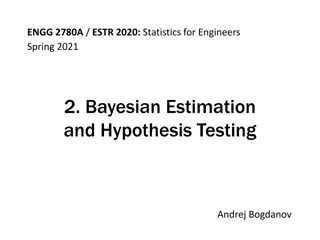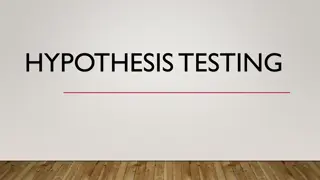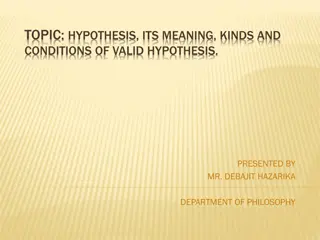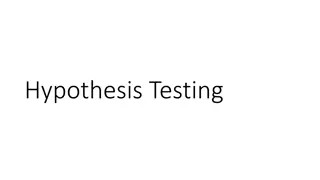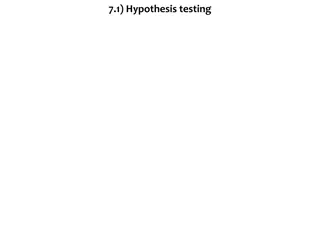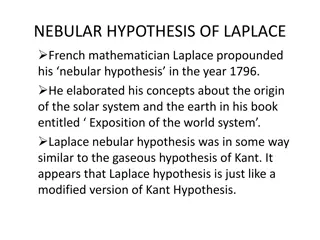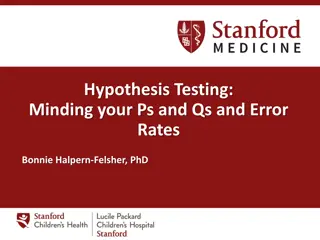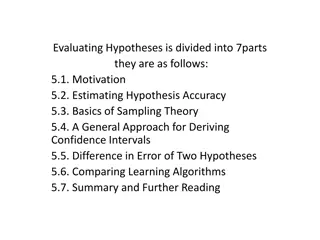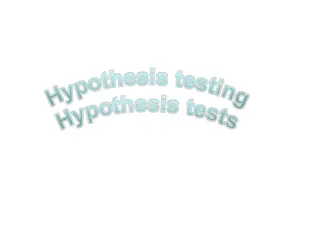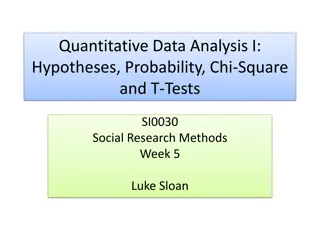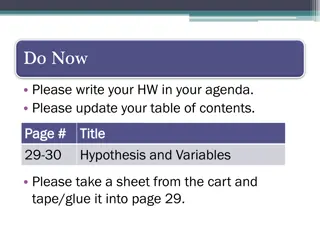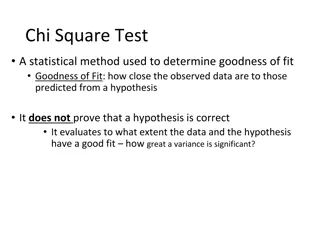
Statistical Hypothesis Testing and Problem Solving Techniques
Explore the world of hypothesis testing and problem-solving methods in statistics through practical examples. Learn how to create your own hypothesis tests, analyze critical values, and make informed decisions based on statistical evidence. Dive into scenarios involving short-term memory improvement, influenza epidemics, and pottery bowl defects to enhance your understanding of statistical analysis.
Download Presentation

Please find below an Image/Link to download the presentation.
The content on the website is provided AS IS for your information and personal use only. It may not be sold, licensed, or shared on other websites without obtaining consent from the author. If you encounter any issues during the download, it is possible that the publisher has removed the file from their server.
You are allowed to download the files provided on this website for personal or commercial use, subject to the condition that they are used lawfully. All files are the property of their respective owners.
The content on the website is provided AS IS for your information and personal use only. It may not be sold, licensed, or shared on other websites without obtaining consent from the author.
E N D
Presentation Transcript
Hypothesis testing Problem solving
Hypothesis testing BAT create your own hypothesis test BAT solve problems with hypothesis tests KUS objectives Starter:
WB 12A psychologist is attempting to help a patient improve their short term memory. One of the tests they use is to present the patient with 10 objects on a tray and let them look at them for one minute before taking the tray away and asking them to write down as many of the objects as they can The psychologist ascertains that the proportion, p, of objects that the patient remembers is 0.35. After a period of time the psychologist is interested to see if there is any change in p. Find the critical values for a two tailed rest using as close to possible to a 2.5% level of significance in each tail. State the actual level of significance Let X = number of objects remembered ?~ ?(10,0.35) ?0: ? = 0.35 proportion of objects remembered ?1: ? 0.35 TWO TAILED ? ? 0 = 0.0135 Critical value X=0 ? ? 1 = 0.0860 ? ? 7 = 1 ? ? 6 = 1 0.9740 = 0.0260 Close to 2.5% Critical value X = 7 ? ? 8 = 1 ? ? 7 = 1 0.9952 = 0.0048 Actual level of significance (0.0135)+(0.0260) = 0.0395 or 3.95%
WB 13Duringan influenza epidemic, a city hospital reports that 6 out of 100 of people tested have influenza on a given day. The manager of a company that employs 100 people find that 11 of the employees were absent that day, claiming to have influenza a) Using a 5% level of significance, find the critical region that would enable the manager to test whether or not there is evidence that the percentage of people in the company having influenza is greater than the proportion in the city b) State a conclusion the manager could make, giving a reason for your answer Let X = number of people with influenza ?~ ?(100,0.06) ?0: ? = 0.06 proportion of people with influenza ?1: ? > 0.06 testing if the proportion is greater ? ? 16 = 1 ? ? 15 = 1 0.9832 = 0.0168 < 5% The evidence supports that we should REJECT the null hypothesis The evidence supports people in the company having influenza is greater than the proportion in the city e.g. the evidence supports the manager concluding there is a high risk of getting influenza amongst the employess NOT anything else!
WB14 It is known from past records that 1 in 5 bowls produced in a pottery have minor defects. To monitor production a random sample of 25 bowls was taken and the number of such bowls with defects was recorded. (a) Using a 5% level of significance, find critical regions for a two-tailed test of the hypothesis that 1 in 5 bowls have defects. The probability of rejecting, in either tail, should be as close to 2.5% as possible. ~ B X ( ) 25 0 , 2 . X = number of defective bowls H0 : p = 0.2 ( X P ( X P Critical region is ( H1 : p 0.2 0274 . ( 10 X P X (b) State the actual significance level of the above test ) ) = = 1 9 0 ) 1 = 0 0173 . X + = 0 0274 . 0 0173 . 0 0447 . ) 10 At a later date, a random sample of 20 bowls was taken and 2 of them were found to have defects. (c) Test, at the 10% level of significance, whether or not there is evidence that the proportion of bowls with defects has decreased. State your hypotheses clearly ( 20 ~ B Y ( Y P Accept H0 as there is insufficient evidence that proportion has decreased ) 0 , ) 2 2 . Y = number of defective bowls 0. 1 = 0 2061 . H0 : p = 0.2 H1 : p < 0.2
Practice 105 D
KUS objectives BAT solve problems with hypothesis tests self-assess One thing learned is One thing to improve is

